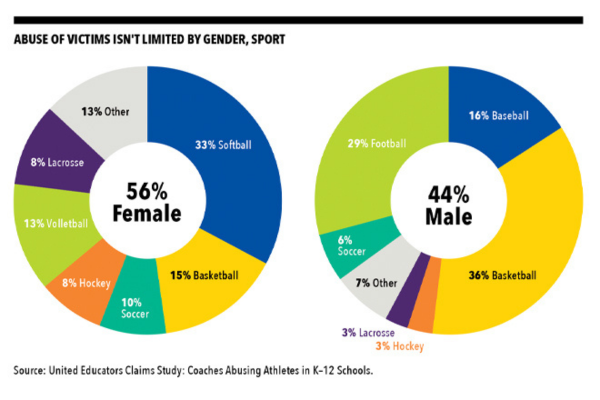Physical and emotional abuse by coaches of athletes at independent K-12 schools is a relatively common occurrence that often goes undisciplined. Insurance claims and news reports make clear this is a widespread concern. At United Educators (UE), we examined 73 member claims received over five years arising from coach-on-athlete abuse of athletes. We excluded sexual abuse from our claims study, and still, financial losses totaled in the millions.
We found two emerging concerns in these claims: lack of oversight of the athletics department, and lack of training to prevent misconduct. Student-athletes’ reported abuse doesn’t always result in action. That is, reports weren’t always investigated unless they reached school administrators outside the athletics department. Extending administrative oversight over athletics department activities and training athletes, parents and coaches to recognize abuse can help protect vulnerable athletes.
Forms of Abuse and Perpetrators
Emotional abuse can take the form of bullying, discrimination or retaliation. In our analysis of claims from 2014-18, it was the most frequent and severe type of athletic coaching misconduct, accounting for 71% of claims and nearly two-thirds of losses.
The other claims involved physical abuse. Some of the most expensive claims stemmed from excessive workouts intended to physically punish student-athletes. Often, claims included physical and emotional abuse. For example, when a player missed a shot, the coach shoved the player and called her names.
Abuse of victims isn’t limited by gender or sport. In our study, softball had the highest percentage of female victims. Basketball had the highest percentage of male victims.
Of the coaches who were abusive, more than half (63%) abused multiple victims, with head coaches committing 83% of incidents of abuse within the study.
Men hold most coaching positions for male and female teams. The abuse rate of male coaches (about 64%) aligned with their representation in the pool of coaches.

Athletics Department Oversight
Athletics departments often have more autonomy than other departments. Left unchecked, predatory coaches can abuse athletes without rebuke.
To help increase oversight, adopt these practices:
Set clear behavioral standards for coaches that prohibit all forms of emotional and physical abuse. In annual coaching contracts and your employee handbook, set clear standards for appropriate behavior. Use athletic conference and sport codes of ethics as templates to help develop standards that are most appropriate for your school.
Prohibitions should include:
- Profanity and insults as ways to “motivate” school athletic teams.
- Intentionally hurting or injuring student-athletes.
- Discriminating against students based on their race, sex, sexual orientation or disability.
- Private one-on-one meetings. In several claims, coaches abused student-athletes in private locations. Limit one-on-one interactions between coaches and athletes to situations where another adult can observe and interrupt if needed.
- Inappropriate touching. Prohibit touching that a person could reasonably interpret as inappropriate, such as patting someone on the behind. Additionally, any physical therapy, massage or rubdown must be conducted with at least one other adult present. Generally, touching should be in the open and for a clear educational, developmental or health-related purpose.
- Forcing injured students to practice or compete.
- Instituting practices as punishment.
- Name-calling, including identity-based shaming or body-shaming.
Give coaches, students and parents an annual statement of behavioral standards for coaches and student-athletes. Require coaches to sign a form stating they understand these standards.
Encourage reporting of misconduct. By implementing a centralized reporting system, schools can train a person or team to respond to abuse reports. This ensures consistent treatment across all reports, eliminating the potential to silo reports arising from athletics.
Strengthen your policies by prohibiting retaliation against those who report suspected abuse. Specify in student and employee handbooks that your school won’t tolerate retaliation against anyone making or cooperating with a report.
Beyond the high human cost, failing to protect athletes from serial perpetrators can lead to reputational harm. Enforcing rules and sanctions helps schools limit predatory conduct and remove bad actors.
Investigate with administrative oversight. Athletics department investigations can be biased, which can lead to liability losses. Consider centralizing employee abuse investigations outside your athletics department. If investigations remain within the department, require administrative oversight of investigations beyond your athletics director.
Enforce standards. Most coaches in this study abused multiple student-athletes. Beyond the high human cost, failing to protect athletes from serial perpetrators can lead to reputational harm. Enforcing rules and sanctions helps schools limit predatory conduct and remove bad actors. Ensure your employee code of conduct includes enforcement procedures and potential sanctions for misconduct.
Conduct thorough screening of potential coaches. Several coaches in our study who were accused of abuse and fired moved on to coach elsewhere. It is important to uncover candidates’ prior bad acts and misrepresentations. Work with legal counsel to develop compliant screening practices that include background checks.
Check SafeSport’s Centralized Database. Sanctioned under the Safe Sport Act, the U.S. Center for SafeSport’s Centralized Disciplinary Database is a searchable list of coaches in the U.S. Olympic and Paralympic movements subject to investigation or sanctions. Schools hiring coaches should search this database in addition to performing other background checks for adults regularly working with minors. And because coaches often move between sports during their careers, don’t limit your database search to the coach’s current sport.
Training To Prevent Misconduct
Coaches, athletics department employees, athletes and parents all should have training to prevent misconduct.
Common Issue 1
Schools fail to train coaches adequately on preventing and reporting suspected misconduct. Many forms of abuse don’t fit traditional understandings of abuse. For example, some coaches target someone for continued verbal abuse. In some cases, fellow coaches don’t stop the hazing they observe by others.
Require all coaches and athletics department employees to complete periodic emotional and physical abuse prevention training. Reference your policies addressing these types of abuse. Consult with counsel to ensure training meets state training requirements.
Common Issue 2
Power differentials create an opening for abuse. Some coaches bully student-athletes based on their perceived inclusion in an oppressed minority group. For example, coaches bully student-athletes based on their perceived race, religion, sexual orientation, weight or disability.
In recent years, a coach was fired after players complained about the coach’s approach to fitness, eating and weight. At another school, a coach made a student sign a contract requiring her to lose weight every week.
Concerns that first appear in higher education often are a precursor to claims we later see at K-12 schools. An emerging issue relates to height and weight discrimination. According to news reports, coaches often bully athletes about their weight. In recent years, a coach was fired after players complained about the coach’s approach to fitness, eating and weight. At another school, a coach made a student sign a contract requiring her to lose weight every week. Legislators in several states are considering discrimination protections based on height or weight, mainly in the employment context. This trend may expand to non-employment discrimination protections. Even if your state or locality does not include height and weight as protected characteristics, consider whether you wish to add these traits to your anti-discrimination policy.
Additionally, schools should provide age-appropriate training to student-athletes on recognizing and reporting coaching abuse. Parents are another important resource to help prevent coaching abuse. Teach parents to identify and report suspected coach abuse.
Public support from school leadership, including the athletics director, can play an important role in strengthening your anti-abuse values. Ideally, offer multiple training formats such as in-person, scenario-based training led by school leadership.
Include training topics on:
- Emotional misconduct, including bullying and hazing.
- Physical misconduct, including excessive workouts.
- Mandatory reporters, employees who must report abuse under state and federal law.
- Reporting processes, how and when to report suspected abuse to school and state authorities.
While many sports traditions can be a way to build community, teamwork and resilience, it’s time to shed what may be long-held coaching norms that are now seen as abusive.
Document all training so if an investigation occurs, your school can quickly identify the frequency and content of training provided.
While many sports traditions can be a way to build community, teamwork and resilience, it’s time to shed what may be long-held coaching norms that are now seen as abusive. It’s essential to keep school athletic environments safe and healthy for your students and campus to thrive.



